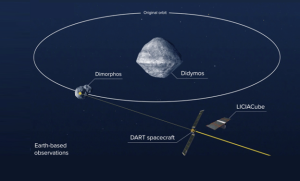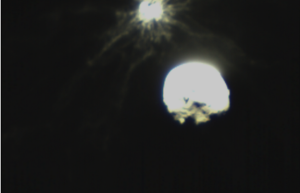Double Asteroid Redirection Test (DART)

Source: NASA
OVERVIEW
The Double Asteroid Redirection Test (DART) mission is focused on asteroid deflection. It is one of the programs conducted by the Planetary Defense Coordination Office (PDCO) through its Near-Earth Object (NEO) Observations Program. DART purposely crashed into a non-Earth threatening asteroid (Dimorphos) on September 26, 2022. The mission will inform the team how well this approach could work in a potential Earth-threatening situation. It is also an opportunity to learn how well computer simulations can portray real-life scenarios.[1]
The spacecraft
The DART spacecraft is home to only one instrument called the Didymos Reconnaissance and Asteroid Camera for Optical navigation (DRACO). John Hopkins Applied Physics Laboratory (APL) created an algorithm (Small-body Maneuvering Autonomous Real Time Navigation [SMARTNav]) to guide the spacecraft to its target. Near the end of DART’s mission, SMARTNav used DRACO’s images to differentiate between Dimorphos and Didymos. Images were transmitted to earth at a rate of once per second by a Radial Line Slot Array high-gain antenna running on a CORE Small Avionics suiTe (CORESAT) computer. Deployable Space Systems Roll-Out Solar Arrays (ROSA) with Transformational Solar Array concentrators were flown by DART in this mission. NASA’s electric propulsion system, Evolutionary Xenon Thruster was powered by ROSA.[2]
mission objectives
- “Demonstrate a kinetic impact with Dimorphos.
- Change the binary orbital period of Dimorphos.
- Use ground-based telescope observations to measure Dimorphos’ period change before and after impact.
- Measure the effects of the impact and resulting ejecta on Dimorphos.”[3]
Team
The APL built the DART spacecraft and is responsible for its operations. APL’s other contributions include mission and investigation team management.[4]
The list of partner institutions includes:
- NASA Goddard Space Flight Center
- Johnson Space Center
- Langley Research Center
- Glenn Research Center
- Marshall Space Flight Center
- Kennedy Space Center and Launch Services Program
- Jet Propulsion Laboratory
- SpaceX
- Aerojet Rocketdyne
- Lawrence Livermore National Laboratory
- Auburn University
- Carnegie Science Las Campanas Observatory
- University of Colorado
- Las Cumbres Observatory
- Lowell Observatory
- University of Maryland
- New Mexico Tech with Magdalena Ridge Observatory
- Northern Arizona University
- Planetary Science Institute
- S. Naval Academy [5]
A full list of NASA’S DART team can be found here.
Recent mission updates
The mission was successfully conducted on September 26, 2022. DART collided with asteroid Dimorphos and proved kinetic impact to be a viable option for deflecting an asteroid. DRACO and SMARTNav were able to work together in targeting the correct asteroid for collision. DART traveled around a speed of 14,000 (22,530 kilometers) per hour at the time of impact. Images of the collision were captured by Light Italian CubeSat for Imaging of Asteroids (LICIACube), a device released from DART fifteen days prior to the collision.[6]
One of the images LICIACube captured shortly after the collision can be found below:

Source: NASA
Additional images taken after the collision between DART and Dimorphos can be found here.
As of October 2022, NASA reports DART was successful in changing Dimorphos’ orbit. The following chart illustrates some of the ways the team established the asteroid’s new orbit after September 26th. For example, brightness and a new eclipse time were monitored.[7]

Source: NASA
The European Space Agency’s Hera project has plans to take surveys of Dimorphos and Didymos in about four years. Their attention will be focused on the crater remaining from the DART collision and obtaining a measurement of Dimorphos’ mass.[8]
Updated November 2022 by Jackie Johnson

Comments are closed.